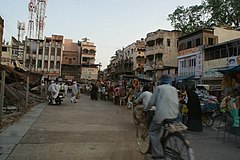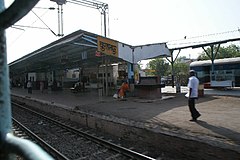Burhanpur
Burhanpur | |
|---|---|
City | |
      From top, left to right: Burhanpur Town Streets, Shahi Qila, Asirgarh Fort, Jama Masjid, Dargaah-e-Hakimi, Burhanpur Rail Station | |
 Burhanpur India Burhanpur | |
| Coordinates: 21°18′N 76°14′E / 21.3°N 76.23°ECoordinates: 21°18′N 76°14′E / 21.3°N 76.23°E | |
| Country | India |
| State | Madhya Pradesh |
| District | Burhanpur |
| Founded | 1380 |
| Government | |
| • Mayor | Anil Bhau Bhosle |
| Area | |
| • Total | 181.06 km2 (69.91 sq mi) |
| Elevation | 247 m (810 ft) |
| Population (2011)[1] | |
| • Total | 210,891 |
| • Density | 1,200/km2 (3,000/sq mi) |
| Languages | |
| • Official | Hindi[2] |
| Time zone | UTC+5:30 (IST) |
| PIN | 450331 |
| Telephone code | (+91) 7325 |
| ISO 3166 code | IN-MP |
| Vehicle registration | MP-68 |
| Website | www |
Burhanpur is a city in the Indian state of Madhya Pradesh. It is the administrative seat of Burhanpur District. It is situated on the north bank of the Tapti River and 340 kilometres (211 mi) southwest of the state's capital city of Bhopal. The city is a Municipal Corporation.
History[]

Pre-Mughal period[]
Burhanpur was an important city under the Rashtrakuta Dynasty from 753–982. Excavations of the Tapti River and Asirgarh Fort have discovered many coins, goddess idols and temples from the prehistoric era. However, Burhanpur came to prominence during the medieval period.
In 1388, Malik Nasir Khan, the Faruqi dynasty Sultan of Khandesh, discovered Burhanpur, at the behest of Shaikh Zainuddin and renamed it after a well-known medieval Sufi saint, Burhan-ud-Din. Burhanpur became the capital of the Khandesh sultanate. Later, Miran Adil Khan II (reigned 1457–1501), another sultan of this dynasty, built a citadel and a number of palaces in Burhanpur.[3] During his long reign, Burhanpur was transformed into a major centre for trade and textile production.
Under the Mughals[]
In 1601, the Mughal emperor Akbar annexed the Khandesh sultanate and Burhanpur became the capital of Khandesh subah,[4] one of three new top-level provinces in the Mughal empire, added in 1601 (like Berar Subah in 1869 and Ahmadnagar subah in 1601–35) to the initial dozen as he conquered much of the Deccan.[citation needed] The city served as the residence of Khandesh's Mughal governor, Abdul Rahim Khan-i-Khanan, during Akbar and Jahangir's rule. He constructed a new water supply for the city, as well as several gardens.[5] In 1609, Mughal emperor Jahangir appointed his second son Parviz to the governorship of the Mughal provinces of the Deccan, and the prince chose Burhanpur as his headquarters and his residence.

Burhanpur became a beautiful city, and many historical monuments survive in its expanse, mainly dating from the rule of the great Mughal emperor Shah Jahan. Burhanpur was an important Mughal outpost. Shah Jahan spent a considerable amount of time in this city, and helped add to the Shahi Qila. The Shahi Qila is one majestic palace in Burhanpur, located to the west of the Tapti River. Diwan-i-Aam and Diwan-i-Khas were built on the terrace of the Qila. Little of it remains today, as the Qila is mostly in ruins. However, the parts of the palace that are still standing display exquisite sculpture and carvings. The main attraction at the palace is the hamam or royal bath. It was specifically built for Shah Jahan's wife, Mumtaz Mahal so that she could enjoy a luxurious bath. It is said that she died there while giving birth to her fourteenth child. Even today, the ceiling has many intricate paintings. One of these paintings depicts a monument which is said to have been the inspiration for the Taj Mahal, her final resting place.[6] She was initially buried there for six months before being moved. The original grave called the Aahukhana is in disrepair.[7][8]
Maratha conquest[]
In 1705, Santaji Ghorpade attacked Burhanpur and Khandesh subha to force the Mughal emperor Aurangzeb to deploy more forces in Khandesh. This in turn relieved some of the pressure on Karnataka and Maratha swarajya from Mughal armies. In 1720s, the city was taken by the Maratha Peshwa Bajirao during his expedition to Malwa and Delhi. In 1750s, a Maratha army under Sadashivrao Bhau, who defeated the Nizam of Hyderabad, took control of the town. At the downfall of the Maratha Empire, the city was given to Maratha Sardar Holkar, Scindia, and then finally in 1818 was handed over to British by the Marathas.[9]
Transport[]
The nearest airport is indore.
Geography[]
Burhanpur is situated on the southwestern border of Madhya Pradesh, near the banks of the Tap(t)i River.
Demographics[]
As 2011 Indian Census, population of Burhanpur in 2011 was 210,886, of which males and females were 108,187 and 102,699 respectively. The population in the age group of 0 to 6 years was 28,930, of which 15,035 were males and 13,895 were females. The total number of literates in Burhanpur was 147,056, which constituted 69.7% of the population with male literacy of 73.3% and female literacy of 65.9%. The effective literacy rate of 7+ population of Burhanpur was 80.8%, of which male literacy rate was 85.1% and female literacy rate was 76.3%. The Scheduled Castes and Scheduled Tribes population was 14,440 and 2,179 respectively. Burhanpur had 38118 households in 2011.[1]
Economy[]
Industries[]
Burhanpur is known for its textile industry. It is the largest hub for the power loom industry in the state. It is also known for having one NTC (National Textile Corporation) project. It has a number of textile companies which are well known for interlining cloths, Grey Markin, Bleached Dhoti, Cambric, Power loom Cloth bakram and other types of fabric. There are also several cotton and oil mills in the city.[10]
Tourism[]

Burhanpur was ruled by several dynasties,[11] and consequently has many visitor attractions of historical interest. It has three rivers, the Tapti, the Utavali and the Mohna, with several natural sights for visitors to Burhanpur. This small town has four small ghats. Being the home of a very diverse population, Burhanpur has a notable Gurudwara,[citation needed] Masjid,[12] Church, a world-famous Dargah[13]
- Asirgarh Fort – The fort built by Asa Ahir of the Ahir dynasty is notable for its historical architecture. This fort during its prime time was difficult to win because of being built at a great height, with strong outer walls which are still standing intact. It is situated on Burhanpur-Khandwa Highway, 20 kilometres (12 mi) from Burhanpur.
- Shahi Qila – A rare fort with a complete garden on its terrace. It was built in the Farooqi Dynasty and ruled by Shahjahan for a long period of time. His beloved wife Mumtaz died here and it is believed that the Taj Mahal was decided to be made in Burhanpur before the plan was cancelled due to lack of white marble here at the time, though Mumtaz was buried here for six months after her death until Taj Mahal construction was completed.
- Jama Masjid – The Jama Masjid is a historic monument as well as a place of worship. It is centrally located in Gandhi Chowk. The construction of Jama Masjid started in Farooqi rule. The construction of the monument took very long and continued even after Farooqi leader Adil Shah's demise. Then Emperor Akbar supervised and completed the work of the Masjid. There are two large minarets, three round cupolas and extensive artwork on its symmetric pillars which are well conserved.[12]
- Dargah-e-Hakimi – The tomb complex 'Dargah-e-Hakimi' includes mosques, gardens, and accommodation facilities for visitors. Here the holy Dawoodi Bohra saint, Sayyedi Abdul Qadir Hakimuddin is buried, with his monument visited by pilgrims from several countries.
Transport[]
Burhanpur is well connected to other cities of India via railway network. The city has one railway station, while regular buses are available for travel to nearby cities. The closest airport is Jalgaon Airport, which is present on south side of the city.
In popular culture[]
- The city is mentioned in Jules Verne's Around the World in 80 Days as Burhampoor.[14]
References[]
- ^ Jump up to: a b "Census of India: Burhanpur". www.censusindia.gov.in. Retrieved 26 October 2019.
- ^ "52nd Report of the Commissioner for Linguistic Minorities in India" (PDF). Nclm.nic.in. Ministry of Minority Affairs. p. 45. Archived from the original (PDF) on 25 May 2017. Retrieved 30 August 2019.
- ^ Shyam, Radhey (1981). The Kingdom of Khandesh. Delhi: Idarah-i-Adabiyat-i-Delli. p. 21.
- ^ Sen, Sailendra (2013). A Textbook of Medieval Indian History. Primus Books. p. 164. ISBN 978-9-38060-734-4.
- ^ Michell, George; Zebrowski, Mark (1999). Architecture and art of the Deccan Sultanates. Cambridge Univ. Press. p. 53. ISBN 0-521-56321-6. OCLC 231789599.
- ^ [1][dead link]
- ^ Safvi, Rana (2 April 2017). "In neglected Burhanpur, where Mumtaz Mahal once rested". The Hindu. Retrieved 31 October 2018.
- ^ Nair, Ramakrishnan M & Sanjeev. "Video: Why Burhanpur, not Agra, was Shah Jahan's first choice for the Taj Mahal". Scroll.in. Retrieved 31 October 2018.
- ^ Jaswant Lal Mehta (1 January 2005). Advanced Study in the History of Modern India 1707-1813. Sterling Publishers Pvt. Ltd. pp. 212–. ISBN 978-1-932705-54-6. Retrieved 2 June 2012.
- ^ "Brief Industrial Profile of Burhanpur District" (PDF). Government of India Ministry of MSME. p. 3. Archived from the original (PDF) on 22 March 2020. Retrieved 24 November 2019.
- ^ "History of Burhanpur, British Rule in Burhanpur, Origin of Burhanpur". Burhanpuronline.in. Retrieved 19 October 2015.
- ^ Jump up to: a b "Burhanpur Tourism, Tourist Places in Burhanpur, Sightseeing Burhanpur". Burhanpuronline.in. Retrieved 19 October 2015.
- ^ "Things to Do - Dargah E Hakimi Burhanpur, Burhanpur, Madhya Pradesh". Nivalink.com. Retrieved 19 October 2015.
- ^ "The Project Gutenberg eBook of Around the World in Eighty Days, by Jules Verne". www.gutenberg.org. Retrieved 6 October 2020.
External links[]
| Wikimedia Commons has media related to Burhanpur. |
| Wikivoyage has a travel guide for Burhanpur. |
- Burhanpur
- Cities and towns in Burhanpur district
- Municipal corporations in Madhya Pradesh
- Former capital cities in India
- Cities in Madhya Pradesh

